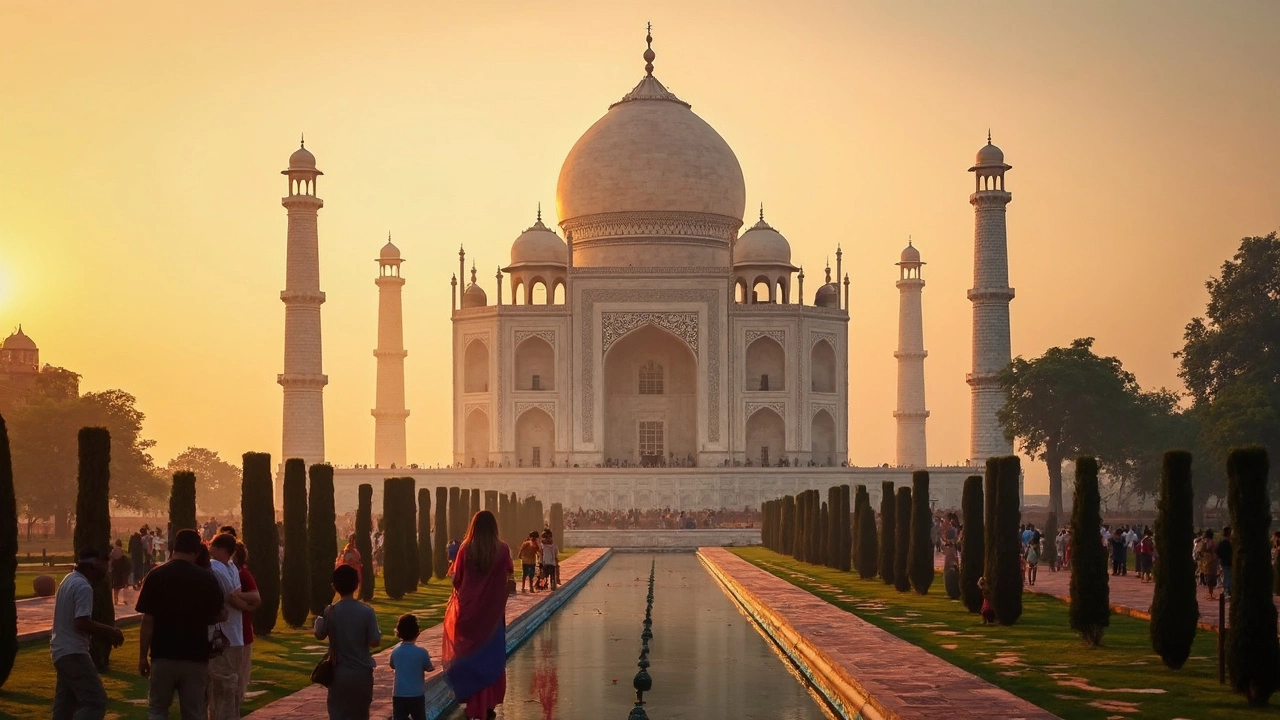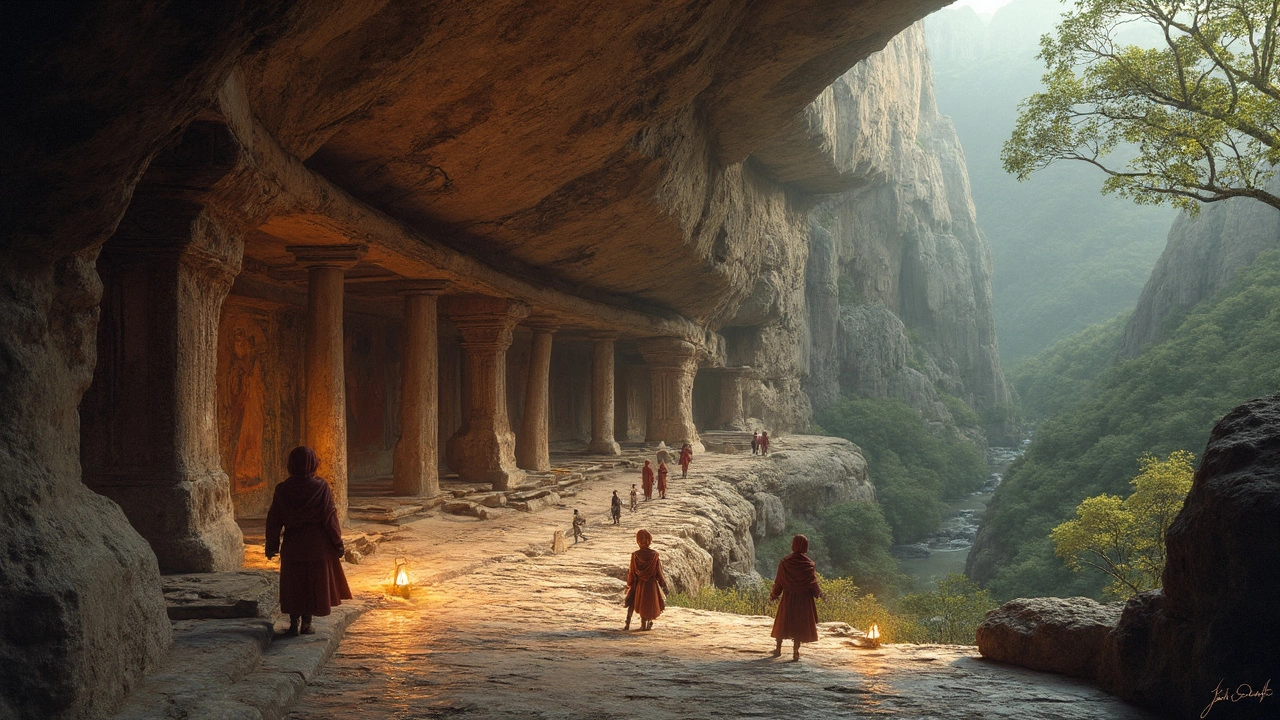Exploring India's Fascinating Heritage Sites
 Feb, 13 2025
Feb, 13 2025
India is like a treasure chest for anyone fascinated by history and culture. Among its many gems are heritage sites that reflect thousands of years of tradition and innovation. Whether it's the grandeur of palaces or the serenity of ancient temples, there's something captivating about these historical landmarks.
The Taj Mahal might be the first thing that pops into your mind when thinking about Indian heritage, and it's hard not to be impressed by this white-marble wonder. But the intriguing part is that India hosts 40 UNESCO World Heritage Sites, each telling its own story. Ever heard about the Sun Temple in Konark or the rock-cut architecture of Ajanta and Ellora Caves? They offer a peek into India's rich past.
The forts and palaces scattered across the country rise with tales of battles, love, and diplomacy. Places like the Red Fort in Delhi and Mehrangarh Fort in Jodhpur showcase the architectural expertise and strategic brilliance of ancient rulers. Meanwhile, India’s diverse culture blends at sites like Hampi, where artistic extravagance mixes with religious significance.
And let's not forget the vibrant cultural festivals that light up these sites. Visiting during these times can offer an authentic peek into regional life from different states of India. So, India's heritage sites aren't just standing relics of the past—they're living stories that continue to thrive and enchant.
- The Legendary Taj Mahal
- Ancient Caves and Temples
- Imposing Forts and Palaces
- Cultural Diversity and Traditions
The Legendary Taj Mahal
When you think of India, the Taj Mahal often steals the spotlight, and it’s not just because of its stunning beauty. Built in the 17th century by Emperor Shah Jahan, this iconic monument in Agra stands as a symbol of love and loss. Dedicated to his beloved wife, Mumtaz Mahal, the Taj Mahal is a must-see if you're exploring India's heritage.
Architectural Wonder
Made from gleaming white marble, the Taj Mahal showcases the pinnacle of Mughal architecture. It blends Islamic, Persian, and Indian architectural styles. The intricate inlay work, known as pietra dura, uses precious gemstones like lapis lazuli and jade, which adds to its grandeur. Did you know that the Taj Mahal’s minarets were built slightly leaning outward to protect the mausoleum during earthquakes? Now that's some smart design!
Visitor Tips
If you're planning a visit, here are some handy tips:
- Arrive early to catch the sunrise view; it's breathtaking and often less crowded.
- There's a soft cap on daily visitors so plan to buy tickets online in advance.
- Footwear isn’t allowed inside the main mausoleum, so be ready to either go shoeless or buy a pair of shoe covers.
A calming atmosphere accompanies the site, with lush gardens that are based on Persian-style high gardens, offering a serene space for visitors to absorb the majesty of the Taj.
Fun Fact
One interesting tidbit is that the color of the Taj Mahal appears to change depending on the time of day—rosy pink in the morning, milky white in the evening, and golden at night under the moonlight. It's no surprise it’s one of the most photographed places in the world, right?
When you think about heritage sites in India, the significance of the Taj Mahal isn't just in its beauty but in the deep emotions it encapsulates. It’s more than a structure; it's a living piece of the past, drawing millions each year to admire its beauty and feel its history.
Ancient Caves and Temples
The ancient caves and temples of India are like stepping into a time machine. These sites offer a unique way to explore India's rich history and culture. If you're thinking about India's heritage sites, they aren't complete without a visit to these awe-inspiring locations.
Ajanta and Ellora Caves
Located in Maharashtra, the Ajanta and Ellora Caves are some of the most famous rock-cut architectures. Dating back to as early as the 2nd century, these caves are a testament to the artistic excellence of ancient Indian civilizations. You’ll find Buddhist, Hindu, and Jain art portrayed through intricate carvings and stunning sculptures. It's like a gallery on stone walls!
Ellora alone boasts 34 caves filled with exquisite artistry. What's fascinating is that these caves were built over a span of 500 years, displaying different techniques and influences.
Sun Temple, Konark
Moving east, the Sun Temple in Konark, Odisha, is another marvel. Dating back to the 13th century, this temple is designed like a gigantic chariot dedicated to the Sun God. Imagine the craftsmanship, with its massive wheels and horses all sculpted from stone. Even though time has taken its toll, you can still see the grandeur that once was.
Khajuraho Temples
The Khajuraho Group of Temples in Madhya Pradesh is famous for its stunning sculptures that depict various aspects of life. Built between 950 and 1050 AD by the Chandela dynasty, these temples are recognized for their erotic carvings blended with everyday scenes. Out of the original 85 structures, 22 have survived, offering a glimpse into both spirituality and art.
Interesting Tidbit: UNESCO Sites
Here’s a bit of trivia to excite your inner history buff: Thirty of these caverns at Ajanta form a UNESCO World Heritage Site. And the whole Khajuraho cluster is also recognized by UNESCO. More than just dusty old sites—they’re global treasures!
These ancient caves and temples aren’t just stone relics; they’re stories carved into stone, showcasing India's cultural diversity and artistic brilliance. Whether you're into history, art, or spirituality, these places promise an unforgettable journey back in time.

Imposing Forts and Palaces
When you think of India's heritage, the majestic forts and palaces stand tall, literally and metaphorically. These structures are not just remnants of history but embody the grandeur and might of ancient and medieval India. They provide an intimate glimpse into the lives of kings and their kingdoms.
The Red Fort
Located in the heart of Delhi, the Red Fort is one of the most iconic symbols of India's rich past. Constructed in 1639 by the Mughal Emperor Shah Jahan, it served as the main residence of the emperors for nearly 200 years. This fort's architecture is a blend of Persian, Timurid, and Indian styles, a true testament to the diverse influences found in Indian culture.
"The Red Fort is the pinnacle of Mughal architecture in India. It's not just a fort; it's a statement of power and beauty," said Diana Preston in her acclaimed book, ‘The Mughals’.
Mehrangarh Fort
Perched high above the city of Jodhpur in Rajasthan, Mehrangarh Fort is a breathtaking sight. Known for its intricate carvings and expansive courtyards, it narrates tales of courage and conquest. Dating back to the 15th century, the fort covers an area of 1,200 acres and the view from the top offers a panoramic spread of the "blue city."
City Palace, Udaipur
The City Palace in Udaipur is a splendid example of Rajput architecture, overlooking Lake Pichola. Built over three centuries with a blend of European and Chinese styles, this palace complex is one of Rajasthan's largest. Each courtyard and corridor holds secrets of the legendary Mewar dynasty.
| Fort/Palace | Location | Built |
|---|---|---|
| Red Fort | Delhi | 1639 |
| Mehrangarh Fort | Jodhpur | 1459 |
| City Palace | Udaipur | 1559 |
These forts and palaces are more than just historical landmarks in India—they're storytellers. Each wall whispers the tales of warriors, grand celebrations, and the artistic sensibilities of an era long gone. Exploring these sites offers an adventure through time.
Cultural Diversity and Traditions
One of the most fascinating aspects of India is its cultural diversity. With more than 2,000 distinct ethnic groups and over 1,600 spoken languages, it's a melting pot that celebrates differences as much as similarities. This diversity isn't just about languages, though. It seeps into every corner of daily life—from food and clothing to festivals and rituals.
Festivals
India is often called the land of festivals. From Diwali, the festival of lights, to the colorful celebration of Holi, these events mark various cultural and religious occasions. But here's the kicker: each region has its own version or way of celebrating these festivals. It's common to find folks celebrating Pongal in Tamil Nadu, while at the same time, Makar Sankranti is observed in the north.
Traditions
Indian traditions are as varied as its geography. In Kerala, for instance, the boat races during Onam are a sight to behold. Music and dance also play a big role in cultural expression. Classical forms like Bharatanatyam and Kathak have been captivating audiences for years, preserving stories through movement and rhythm.
What sets India apart is how seamlessly ancient traditions blend with modernity. While metropolitan hubs buzz with innovation, many cities still adhere to traditional customs, ensuring that heritage stays alive.
Cuisine
The diversity extends to the culinary scene as well. Cuisine can change as you move from one state to another. From spicy dishes in Andhra Pradesh to the sweet delicacies of Bengal, each region offers something unique. The use of spices is an art that turns ordinary ingredients into extraordinary meals.
| State | Main Dish | Famous Festival |
|---|---|---|
| Punjab | Butter Chicken | Lohri |
| West Bengal | Rasgulla | Durga Puja |
| Goa | Vindaloo | Carnival |
Exploring India through its heritage sites, festivals, and traditions offers a vivid picture of its multifaceted culture. It's like a colorful mosaic—every piece holds a story, and together they create the incredible tapestry of India.